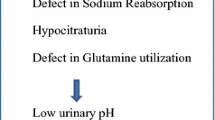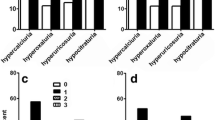Abstract
Purpose
To investigate whether atorvastatin has favorable effects on urinary metabolic risk factors associated with urolithiasis.
Methods
Sixteen male Sprague–Dawley rats were randomly divided into two groups, and baseline spot and 24-h urine samples were collected. Distilled water and atorvastatin were administered to rats during 4 weeks in the control and atorvastatin groups, respectively. At the end of the experimental procedure, spot and 24-h urine samples were collected again. Citrate, oxalate, cystine, uric acid, calcium and magnesium levels were determined in 24-h urine samples. Citrate/creatinine, oxalate/creatinine, uric acid/creatinine, calcium/creatinine and magnesium/creatinine ratios were also calculated in spot urine samples. Comparison of the baseline and post-experimental levels of these parameters was made in each group.
Results
The majority of the parameters were similar before and after the experimental procedure in each group. In the atorvastatin group, uric acid and calcium levels were affected. Administration of atorvastatin was significantly decreased the levels of uric acid, whereas increased the levels of calcium (P = 0.025 and P = 0.017, respectively).
Conclusions
Our study revealed that atorvastatin has decreasing effect on UUa levels, whereas increasing effect on UCa levels. We think it cannot certainly be deduced that atorvastatin could be beneficial on overall urinary metabolic risk factors. Contrarily, atorvastatin may lead to an increased risk of calcium stones, but when considering its UUa decreasing effect, it may help in reducing the uric acid stone recurrence.
Similar content being viewed by others
References
Knoll T, Schubert AB, Fahlenkamp D, Leusmann DB, Wendt-Nordahl G, Schubert G (2011) Urolithiasis through the ages: data on more than 200,000 urinary stone analyses. J Urol 185:1304–1311
Damasio PC, Amaro CR, Padovani CR, Leitão VA, Yamamoto H, Amaro JL (2014) Influence of clinical therapy and nutritional counseling on the recurrence of urolithiasis. Acta Cir Bras 29:400–404
Gupta G, Paul MR, Kumar S, Devasia A, Mahendri NV, Samuel P, Kekre NS, Chacko NK (2012) Does urinary metabolic assessment in idiopathic calcium nephrolithiasis matter? A matched case control study among Indian siblings. Indian J Urol 28:409–413
Tsujihata M, Momohara C, Yoshioka I, Tsujimura A, Nonomura N, Okuyama A (2008) Atorvastatin inhibits renal crystal retention in a rat stone forming model. J Urol 180:2212–2217
Ekeruo WO, Tan YH, Young MD, Dahm P, Maloney ME, Mathias BJ, Albala DM, Preminger GM (2004) Metabolic risk factors and the impact of medical therapy on the management of nephrolithiasis in obese patients. J Urol 172:159–163
Park S, Pearle MS (2005) Urolithiasis: update on metabolic evaluation of stone formers. Sci World J 5:902–914
Skolarikos A, Straub M, Knoll T, Sarica K, Seitz C, Petřík A, Türk C (2015) EAU guidelines. Eur Urol 67:750–763
Xu H, Zisman AL, Coe FL, Worcester EM (2013) Kidney stones: an update on current pharmacological management and future directions. Expert Opin Pharmacother 14:435–447
Shirfule AL, Racharla V, Qadri SS, Khandare AL (2013) Exploring antiurolithic effects of gokshuradi polyherbal ayurvedic formulation in ethylene-glycol-induced urolithic rats. Evid Based Complement Altern Med. https://doi.org/10.1155/2013/763720
Sur RL, Masterson JH, Palazzi KL, L’Esperance JO, Auge BK, Chang DC, Stoller ML (2013) Impact of statins on nephrolithiasis in hyperlipidemic patients: a 10-year review of an equal access health care system. Clin Nephrol 79:351–355
Thompson PD, Panza G, Zaleski A, Taylor B (2016) Statin-associated side effects. J Am Coll Cardiol 67:2395–2410
Gazzerro P, Proto MC, Gangemi G, Malfitano AM, Ciaglia E, Pisanti S, Santoro A, Laezza C, Bifulco M (2012) Pharmacological actions of statins: a critical appraisal in the management of cancer. Pharmacol Rev 64:102–146
McKenney JM (2003) Pharmacologic characteristics of statins. Clin Cardiol 26:32–38
Schaefer EJ, McNamara JR, Tayler T, Daly JA, Gleason JL, Seman LJ, Ferrari A, Rubenstein JJ (2004) Comparisons of effects of statins (atorvastatin, fluvastatin, lovastatin, pravastatin, and simvastatin) on fasting and postprandial lipoproteins in patients with coronary heart disease versus control subjects. Am J Cardiol 93:31–39
DiNicolantonio JJ, Lavie CJ, Serebruany VL, O’Keefe JH (2013) Statin wars: the heavyweight match-atorvastatin versus rosuvastatin for the treatment of atherosclerosis, heart failure, and chronic kidney disease. Postgrad Med 125:7–16
Deutsche Bank Markets Research (2012) Industry European pharmaceuticals. Pharm Begin. https://workspace.imperial.ac.uk/ref/Public/UoA%2011%20-%20Computer%20Science%20and%20Informatics/4IXICO/A%20Market%20Research%20Deutsche%20Bank.pdf. Accessed 21 Oct 2017
Bonetti PO, Lerman LO, Napoli C, Lerman A (2003) Statin effects beyond lipid lowering—are they clinically relevant? Eur Heart J 24:225–248
Laws PE, Spark JI, Cowled PA, Fitridge RA (2004) The role of statins in vascular disease. Eur J Vasc Endovasc Surg 27:6–16
Bagga HS, Chi T, Miller J, Stoller ML (2013) New insights into the pathogenesis of renal calculi. Urol Clin North Am 40:1–12
Chen MH, Weng SF, Hsu CC, Lin HJ, Su SB, Wang JJ, Guo HR, Huang CC (2016) Urolithiasis risk: a comparison between healthcare providers and the general population. BMC Health Serv Res 16:273. https://doi.org/10.1186/s12913-016-1539-7
Kadlec AO, Greco K, Fridirici ZC, Hart ST, Vellos T, Turk TM (2012) Metabolic syndrome and urinary stone composition: what factors matter most? Urology 80:805–810
Akarken I, Tarhan H, Ekin RG, Cakmak O, Koc G, Ilbey YO, Zorlu F (2015) Visceral obesity: a new risk factor for stone disease. Can Urol Assoc J 9:E795–E799
Inci M, Demirtas A, Sarli B, Akinsal E, Baydilli N (2012) Association between body mass index, lipid profiles, and types of urinary stones. Ren Fail 34:1140–1143
Milionis HJ, Kakafika AI, Tsouli SG, Athyros VG, Bairaktari ET, Seferiadis KI, Elisaf MS (2004) Effects of statin treatment on uric acid homeostasis in patients with primary hyperlipidemia. Am Heart J 148:635–640
Seo JW, Lee JH, Son IS, Kim YJ, Kim DY, Hwang Y, Chung HA, Choi HS, Lim SD (2012) Acute oxalate nephropathy caused by ethylene glycol poisoning. Kidney Res Clin Pract 31:249–252
Cederbaum AI (2012) Alcohol metabolism. Clin Liver Dis 2012(16):667–685
Cederbaum AI (2015) Molecular mechanisms of the microsomal mixed function oxidases and biological and pathological implications. Redox Biol 4:60–73
Kolovou GD, Salpea KD, Anagnostopoulou KK, Mikhailidis DP (2006) Alcohol use, vascular disease, and lipid-lowering drugs. J Pharmacol Exp Ther 318:1–7
Acknowledgements
We want to thank staffs of Experimental Animals Laboratory of Bagcilar Training and Research Hospital for their valuable supports during the experimental procedures.
Author information
Authors and Affiliations
Corresponding author
Ethics declarations
Conflict of interest
All authors declare to have no conflict of interest.
Rights and permissions
About this article
Cite this article
Temiz, M.Z., Yuruk, E., Ertas, K. et al. Effects of statin treatment with atorvastatin on urolithiasis-associated urinary metabolic risk factors: an experimental study. Int Urol Nephrol 50, 231–236 (2018). https://doi.org/10.1007/s11255-017-1762-0
Received:
Accepted:
Published:
Issue Date:
DOI: https://doi.org/10.1007/s11255-017-1762-0




